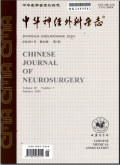婴幼儿脑积水脑室-腹腔分流术后感染的危险因素分析
Risk factors of infection after ventriculoperitoneal shunting in infants with hydrocephalus
摘要目的:探讨影响婴幼儿脑积水脑室-腹腔分流术后感染的危险因素。方法:回顾性分析2013年3月至2017年3月郑州大学第三附属医院神经外科行脑室-腹腔分流术治疗的427例脑积水患儿的临床资料。术后根据患儿的局部临床症状和实验室检查结果判断是否发生感染。进一步采用单因素和多因素logistic回归分析法判断影响患儿术后出现感染的危险因素。结果:427例患儿中,50例诊断为术后感染,377例无感染。50例术后感染患儿的临床表现为,头痛11例、呕吐15例、局部皮肤红肿7例、发热12例、步态不稳2例、肠梗阻3例;脑脊液或深拭子培养结果显示,致病菌为表皮葡萄球菌31例(62.0%)、金黄色葡萄球菌10例(20.0%)、革兰阴性杆菌5例(10.0%)、其他菌群4例(8.0%)。单因素分析结果显示,患儿早产、月龄、脑积水严重程度及手术时间是影响患儿术后出现感染的临床因素(均 P<0.05)。进一步多因素logistic回归分析结果显示,早产( OR=3.687,95% CI:1.937~7.017, P<0.001)、月龄≤6个月( OR=0.385,95% CI:0.155~0.953, P=0.039)、重度脑积水( OR=0.494,95% CI:0.259~0.943, P=0.033)及手术时间>1 h( OR=0.345,95% CI:0.180~0.659, P=0.001)是患儿术后出现感染的独立危险因素。 结论:有早产史、月龄小、脑积水程度重及手术时间长的脑积水患儿在行脑室-腹腔分流术后易发生感染。
更多相关知识
abstractsObjective:To explore the risk factors of infection in infants with hydrocephalus after ventriculoperitoneal shunting.Methods:The clinical data of 427 children with hydrocephalus undergoing ventriculoperitoneal shunting at Neurosurgery Department of the Third Affiliated Hospital of Zhengzhou University from March 2013 to March 2017 were retrospectively analyzed in this study. According to the clinical symptoms at the local site and results of laboratory examination, the presence or absence of infection of the patients was determined. Furthermore, unirariate and multivariate logistic regression analysis were used to investigate the risk factors of postoperative infection.Results:Of the 427 children, 50 were diagnosed as postoperative infection (infection group) and 377 as non-infection (non-infection group). The clinical manifestations of 50 children with confirmed infection were headache in 11 cases, vomiting in 15, local skin swelling in 7, fever in 12, gait instability in 2 and intestinal obstruction in 3. The results of cerebrospinal fluid or deep swab culture showed that the pathogens were Staphylococcus epidermidis in 31 cases (62.0%), Staphylococcus aureus in 10 (20.0%), gram negative bacilli in 5 (10.0%), and other bacteria in 4 (8.0%). The results of univariate analysis showed that preterm delivery, age, severity of hydrocephalus and operation duration were the influencing factors of postoperative infection (all P<0.05). Further multivariate logistic regression analysis showed that preterm delivery ( OR = 3.687, 95% CI: 1.937-7.017, P < 0.001), age ≤ 6 months ( OR = 0.385, 95% CI: 0.155-0.953, P = 0.039), severe hydrocephalus ( OR = 0.494, 95% CI: 0.259-0.943, P = 0.033) and operation duration > 1 h ( OR = 0.345, 95% CI: 0.180-0.659, P = 0.001) were independent risk factors for postoperative infection. Conclusions:The risk factors of infection in children with hydrocephalus after ventriculoperitoneal shunting include preterm delivery history, small age, heavy degree of hydrocephalus and long operation duration.
More相关知识
- 浏览336
- 被引8
- 下载268


相似文献
- 中文期刊
- 外文期刊
- 学位论文
- 会议论文



 换一批
换一批 换一批
换一批



